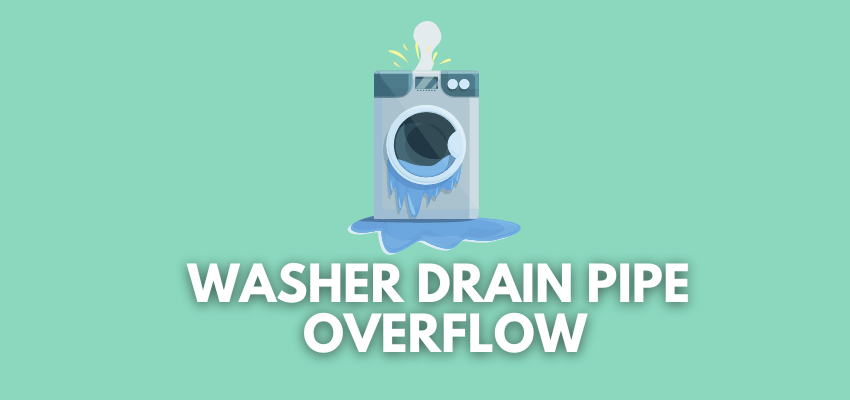Table of Contents
Last Updated on: 30th July 2023, 12:29 pm
Washing machine drain pipes are key to draining out the dirty water from the washing machine. However, if the drain pipe overflows, it can cause a lot of problems for the end users.
The washing machine drain pipe overflowing can be a frustrating and messy problem to deal with. Several factors can contribute to this issue, ranging from simple clogs to more complex plumbing problems.
Let’s explore the common reasons why your washing machine drain pipe may be overflowing and provide some possible solutions.
| Disclaimer: As an Amazon Associate, I earn from qualifying purchases. |
Washing Machine Drain Pipe Overflow: Reasons and Solutions
Let’s shed some light on the possible issues with the drain pipe and how to fix them:
Clogged Drain Pipe
One of the most common causes of a washing machine drain pipe overflow is a clog in the pipe itself. Over time, lint, soap residue, and other debris can accumulate in the drain pipe, obstructing the flow of water. When the pipe is clogged, water may back up and overflow from the drain pipe.
Solution: Start by removing any visible debris from the drain pipe opening. Then, try using a plumber’s snake or a wire coat hanger to dislodge any stubborn clogs further down the pipe. If the clog persists, you may need to call a professional plumber to assess and clear the blockage.
Clogged Standpipe or Drainage System
In some cases, the issue may not lie directly within the washing machine drain pipe but rather in the standpipe or the overall drainage system. The standpipe is the vertical pipe into which the washing machine drain hose is inserted. If the standpipe is partially or completely clogged, water may overflow during the draining process.
Solution: Inspect the standpipe for any visible clogs or blockages. Remove any debris that you can reach using gloves or a long-handled brush. If the problem persists, you may need to call a plumber to assess and clear the clog within the standpipe or the drainage system.
Insufficient Ventilation
Proper ventilation is crucial for the effective drainage of your washing machine. If the plumbing vent, which allows air to enter the system and balance the pressure, is blocked or inadequate, it can lead to slow or incomplete drainage. This, in turn, can cause the drain pipe to overflow.
Solution: Check the plumbing vent on your roof or exterior wall to ensure it’s clear of debris, such as leaves or bird nests. If you suspect a ventilation issue, it’s advisable to consult a professional plumber who can assess and address the problem appropriately.
Drain Pump Malfunction
The drain pump is responsible for expelling water from the washing machine during the drain cycle. If the drain pump is faulty or clogged, it may not be able to effectively remove the water, causing it to overflow from the drain pipe.
Solution: Start by checking the drain pump for any visible signs of damage or blockage. Clean out any debris that may be obstructing the pump. If the pump appears to be malfunctioning or damaged, it’s recommended to contact a professional appliance repair technician to diagnose and repair the issue.
Improper Drain Hose Installation
Incorrect installation of the drain hose can also contribute to an overflow problem. If the hose is inserted too far into the standpipe or if it’s positioned at a level below the recommended height, it can create a siphoning effect, leading to water overflow.
Solution: Ensure that the drain hose is properly installed according to the manufacturer’s guidelines. It should be inserted into the standpipe but not too far, leaving a gap for air to enter. Additionally, make sure the drain hose is positioned at the correct height to prevent siphoning. Adjust the hose if necessary to improve drainage.
A washing machine drain pipe can overflow due to various reasons, including clogged pipes, standpipes, or drainage systems, insufficient ventilation, drain pump malfunctions, or improper hose installation.
By identifying the underlying cause and following the suggested solutions, you can effectively resolve the issue and prevent future overflows.
Washing Machine Water Drains Out While it is Filling: How to Fix It
There are a few possible reasons why your washing machine’s water drains out while it is filling.
Here are some of the most common causes and how to fix them:
The drain hose is not properly installed
The drain hose should be connected to the drain pipe at a height of at least 30 inches.
If the hose is too low, it can create a siphoning effect that will cause the water to drain out while the washing machine is filling. To fix this, you will need to raise the drain hose or install an anti-siphon clip.
The drain hose is clogged
A clogged drain hose can also prevent the washing machine from filling properly. To check for a clog, disconnect the drain hose from the washing machine and run water through it. If the water flows freely, then the hose is not clogged. If the water does not flow freely, you will need to clear the clog.
The water inlet valve is defective
The water inlet valve is responsible for supplying water to the washing machine. If the valve is defective, it can cause the washing machine to drain out while it is filling.
To test the water inlet valve, you can unplug the washing machine and disconnect the water hoses from the valve. Then, turn on the water supply and check for leaks. If there are no leaks, then the valve is defective and will need to be replaced.
The control board is defective
The control board is the brain of the washing machine and controls all of the functions of the machine. If the control board is defective, it can cause the washing machine to drain out while it is filling. To test the control board, you will need to have it diagnosed by a qualified technician.
If you have checked all of the above causes and you are still having problems, then you may need to call a qualified technician to diagnose the problem.
Here are some additional tips to help you prevent your washing machine from draining out while it is filling:
- Make sure that the drain hose is properly secured to the washing machine and the drain pipe.
- Check the drain hose regularly for leaks or clogs.
- Clean the debris filter and mesh filter in the washing machine drum regularly.
- If you live in an area with hard water, use a water softener to prevent mineral buildup in the washing machine.





